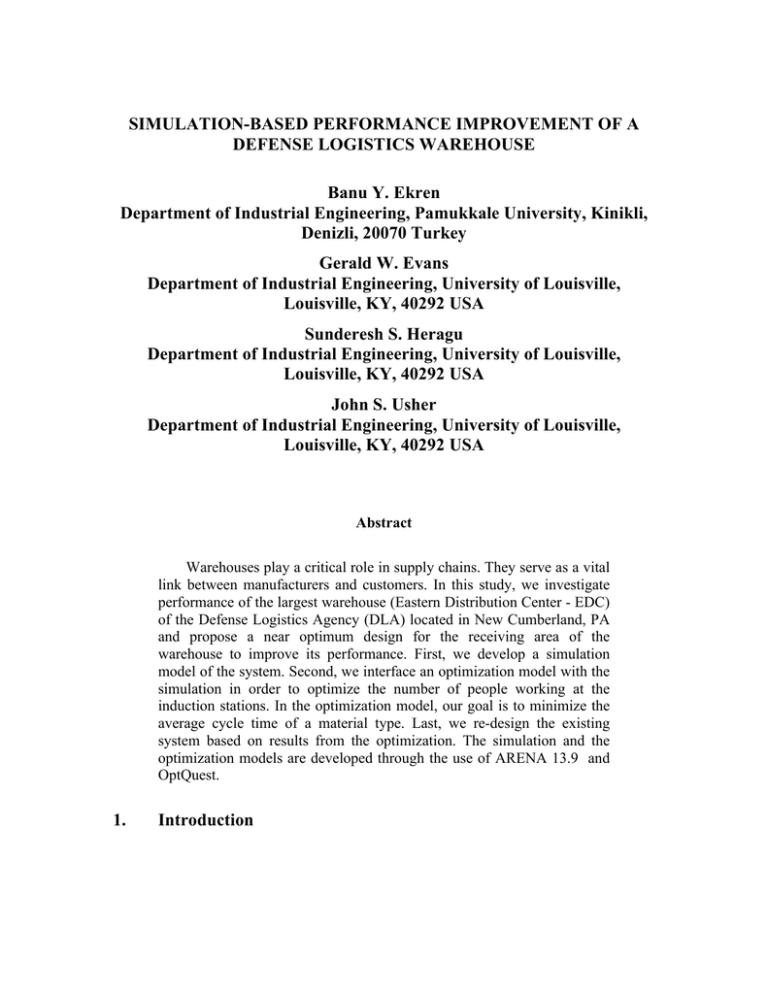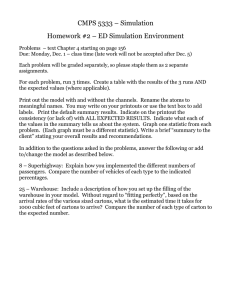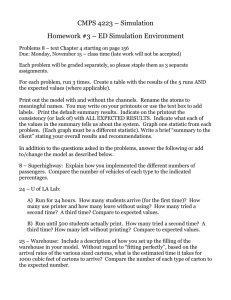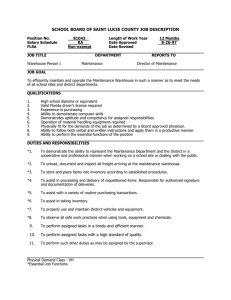SIMULATION-BASED PERFORMANCE IMPROVEMENT OF A DEFENSE LOGISTICS WAREHOUSE Banu Y. Ekren
advertisement

SIMULATION-BASED PERFORMANCE IMPROVEMENT OF A DEFENSE LOGISTICS WAREHOUSE Banu Y. Ekren Department of Industrial Engineering, Pamukkale University, Kinikli, Denizli, 20070 Turkey Gerald W. Evans Department of Industrial Engineering, University of Louisville, Louisville, KY, 40292 USA Sunderesh S. Heragu Department of Industrial Engineering, University of Louisville, Louisville, KY, 40292 USA John S. Usher Department of Industrial Engineering, University of Louisville, Louisville, KY, 40292 USA Abstract Warehouses play a critical role in supply chains. They serve as a vital link between manufacturers and customers. In this study, we investigate performance of the largest warehouse (Eastern Distribution Center - EDC) of the Defense Logistics Agency (DLA) located in New Cumberland, PA and propose a near optimum design for the receiving area of the warehouse to improve its performance. First, we develop a simulation model of the system. Second, we interface an optimization model with the simulation in order to optimize the number of people working at the induction stations. In the optimization model, our goal is to minimize the average cycle time of a material type. Last, we re-design the existing system based on results from the optimization. The simulation and the optimization models are developed through the use of ARENA 13.9 and OptQuest. 1. Introduction Warehouses are critical for a supply chain. Their main role is to buffer materials along the supply chain to adjust variability caused by any factors such as product seasonality, combined transportations, and price policies. Although companies have investigated ways of supplying customers directly from manufacturing plants, this may not always be possible. Due to tight lead-time considerations, it is often easier for companies to operate in the ‘make-to-stock’ mode rather than the ‘make-to-order’ mode. As a result, it is important and often necessary to have intermediate warehouses to achieve high customer service goals. Managing the process of receiving, inducting, and storing the inventory is important to achieve high rates of throughput and service while utilizing lower levels of resource in a warehouse. The basic operations in a warehouse are to receive goods from suppliers, store these goods, receive orders from customers, retrieve goods and ship them to customers. Receiving is the arrival of goods to a warehouse via carrier and unloading of goods at the receiving docks. In most warehouses, received goods are put away into storage and later picked and shipped through shipping docks. In this case, the receiving and shipping operations become more complex to manage since they are coupled with the storage and order picking function. Storage is the organization of goods stored in the warehouse. It is a significant warehouse operation and achieves high space utilization while facilitating efficient material handling. Assignment of items to warehouse departments, space allocation, zoning policy can be considered in a storage operation. Besides, different storage strategies can be used in a storage operation such as random, class-based, and dedicated storage [1]. The selection of a specific storage policy is usually considered as a design problem. Order picking is one of the most expensive warehouse operations, because it tends to be either very labor intensive or very capital intensive [2]. Managing the order picking process requires the organization of the orders to be picked and of the material handling operations of the picking. The selection of an order picking method is a strategic decision since it has a wide impact on many other decisions in warehouse design and operation. There are various issues that should be considered in designing and operating a warehouse to meet the requirements. For instance, resources, such as space, labor, and equipment, should be allocated among the warehouse operations carefully. Also, the warehouse operations should be coordinated carefully in order to achieve system requirements in terms of capacity, throughput, and service at the minimum resource cost. In this study, we investigate the performance of the largest warehouse (Eastern Distribution Center - EDC) of the Defense Logistics Agency (DLA) located in New Cumberland, PA and propose an alternate design based on properly distributed workers for the induction stations. This paper is organized as follows. In the next section, we present related studies from the literature. In Section 3, we detail the simulation modeling of the system by providing the assumptions and the optimization model. We also interpret the results in this section. In Section 4, we give conclusions and future research directions. 2. Literature Review There are a number of studies about warehouse design in the literature. Five major decisions that are considered in warehouse design are: determining the overall structure, warehouse sizing and dimensioning, designing department layouts, selecting equipment and deciding operation strategies [3]. Gu et al. ([3], [4]) propose two comprehensive survey studies on warehouse operation, design and performance evaluation problems. As they mentioned in their survey, most of the literature studies are related with storage and the order picking warehouse operations [4]. Receiving and shipping operations in a warehouse is very limited and is not as well studied as storage and order picking operations. Receiving and shipping can be described as the interface of a warehouse for incoming and outgoing material flow. These operations usually involve assignment of trucks to docks, scheduling of loading and unloading activities, and assignment of labors to proper works. The basic information required in making receiving and shipping operation decisions usually include: (i) information concerning incoming shipments: arrival time and contents of carriers, (ii) information about demands: orders and their expected shipping time, (iii) information about warehouse dock layout and material handling resources used. Using this information, one would like to determine: (i) the assignment of inbound and outbound carriers to docks, (ii) the scheduling of the service of carriers at each dock, (iii) the allocation and dispatching of material handling resources and labors. The existing studies on receiving and shipping have focused on the carrier-to-dock assignment problem for cross-docking warehouses. In a cross-docking warehouse, inbound trucks arrive into the receiving doors of the warehouse for unloading. The unloaded goods are staged according to their destinations, and then they are loaded onto outbound trucks for delivery to customers. The decisions in a cross-docking warehouse problem mostly focus on designating the doors for inbound or outbound trucks to minimize the total operational cost. Tsui and Chang [5] studied receiving/shipping problem where trucks arrive from vendors to have their shipments unloaded, staged and, reloaded onto outbound trucks to deliver customers. They propose a microcomputer based tool based on a bilinear program for recognition of the shipping pattern, and the assignment of the dock doors. In another study, Tsui and Chang [6] propose a bilinear model to assign inbound and outbound trucks to pre-designated doors. Gue [7] studies an optimum model for assignment of inbound trucks to receiving doors and assignment of destinations to shipping doors. He estimates the operational cost by using a local search procedure to find an efficient door layout. Bartholdi and Gue [8] study a cross-docking warehouse door layout problem to minimize the total travel time and waiting time due to congestion. They propose a transportation and queuing model for a fixed door layout. Then they integrate the developed cost model in a simulated annealing algorithm to find a near-optimum door layout. As mentioned earlier, there are very limited studies on shipping and receiving operations in the literature and most of them address shipping and receiving operations and truck-to-dock assignment strategies for cross-docking warehouses. Different from the existing studies, we present a simulation-based optimization model to allocate existing labor in the receiving area optimally to decrease the average cycle time of a received material. We implement our study for a real case warehouse problem. Details of the simulation model and the problem are provided in the following section. 3. Simulation Modeling of the Warehouse DLA is the Department of Defense's largest logistics combat support agency providing worldwide logistics support to the military services as well as several civilian agencies and foreign countries. There are seventeen DLA distribution centers in the US and nine in the other countries (See Figure 1). DLA receives hundreds of thousands of products from various manufacturers and must route them to military bases, forward operating bases or the battlefield, when needed, either directly or via other warehouses. We investigate the performance of DLA Distribution Susquehanna, PA., which is the eastern DLA Strategic Distribution platform, with facilities at New Cumberland and Mechanicsburg, providing military and commercial repair parts, clothing and textiles, medical supplies and industrial and electronic components to military customers throughout the United States and the world. Figure 1: DLA distribution centers in USA and in other countries First, we develop a simulation model of the receiving area of the EDC. Then, we propose a near-optimized model to decrease the average cycle time of a material type. Here, the cycle time is the time from when a material is unloaded from a truck until it is inducted. After trucks are unloaded, materials are staged around the docks to be sent to the proper induction stations to be inspected before they are stowed. Induction process is completed by the DLA staff - Material Examiner Identifier (MEI). In this process, MEIs open the boxes, count the items, check the information on the papers, and match them with the information of the WMS. This process time changes based on the material type, size and the package type of a material inducted. The simulated system is large and complex. EDC handles over 874,000 items which are worth $11 billion arriving at the warehouse on average 25 trucks per day. There are a total of 58 induction stations and on average 75 workers on material handling equipment that ranges from a conveyor to forklift to tow carts and person on board storage and retrieval systems. It is virtually impossible to model this system analytically. For this reason and because we want to capture the finer details of the receiving process, we use simulation. The induction process at EDC is vastly different from that seen in large commercial warehouses such as those managed by UPS, Wal-Mart, Ann Taylor, Jo-Ann and other retailers. There is a high degree of variability in the size, weight, shape, quantity, and handling requirements of the products handled at EDC. In the system there are two types of trucks arriving to the EDC: small parcel carrying trucks – SPTs – and large item carrying trucks - LTs. Small parcels (SPs) and large items (LIs) are in box and pallet formats respectively and change in size and weights. After they are unloaded, SPs and LIs are segregated into two and three groups based on their weights and sizes, respectively. Each group is inducted in separate induction stations. Therefore, there are five main induction stations in the receiving area – I1, I2, I3, I4, I5. We use deterministic arrival times for both truck types which are the data of last six months of year 2011. In other words, we use the same arrival times and number of pieces for LTs as in the data file. There are two main types of materials. Here, we call it as material type 1 (M1) and material type 2 (M2). Seventy percent of the items in trucks are M1 and thirty percent are M2. Ninety-five percent of boxes in a SPT weigh less than 40lbs. and can be transferred by conveyors. Pallets in an LT are segregated into three groups based on fifty-five, forty and five percent proportions. The first, second and third groups are inducted in I3, I4 and I5, respectively. The assumptions of the simulation model of the EDC are summarized below: 1. Two types of trucks arrive at the EDC facility, SPTs and LTs 2. SPTs arrive at a specific door and LTs arrive at any of the ten designated doors randomly. 3. No arrivals occur on holidays and weekends. 4. There are three shifts and each has two 15 minutes and one lunch/dinner breaks. 5. There is also an extra shift on Thursday and Friday. 6. The number of unload workers and MEIs change according to shifts (scheduled numbers are used). 7. Unloading a truck has the highest priority. For example, when a truck arrives, the unload workers will first perform unloading operations. 8. SPTs arrive to the EDC three times a day – two in the morning and one in the afternoon. 9. Morning trucks have 400-600 boxes (shipments) and afternoon truck has 900-2000 boxes. Same number of pieces in truck is used as in truck schedule file for LT. 10. 95% of boxes in a SPT weigh less than 40lbs. 11. The probability that a box is an M1 or M2 is 70%, 30% respectively. 12. If a box weighs less than 40 lbs. and is an M1 it is sent to I1 via conveyor; if it is an M2 then it is sent to I2 via tow carts. 13. If a box weighs more than 40 lbs. it is inducted in I2. 14. For SPT, if I1 line is busy (queue length is greater than 150 in total) it stops to send more jobs to I1 and boxes are kept Triwalls. 15. If I2 has more than 130 jobs then the boxes are staged in the staging area. 16. Two forklifts are seized to unload an LT. These are always available in the area. First, the unloaded pallets are staged and labeled. Then, they are transferred to the appropriate induction station via forklifts. 17. There are three main induction stations for materials unloaded from LTs. 55%, 40% and 5% of the materials in an LT are sent to I3, I4 and I5, respectively. 18. M1 has higher priority in the induction process. 19. There are 12, 4 and 2 available MEI induction stations at I3, I4 and I5, respectively. There are 17 stations in I1 and 15 in I2. 3.1 Simulation Model Testing, Running and Validation The simulation model is developed using ARENA 13.9 (Kelton, Sadowski, and Swets [9]), a commercial simulation software. After developing the model, we run the simulation model for 10 replications and observe the average cycle time of M1 and M2 type of materials separately as performance measure. The model is validated, verified, debugged and animated. The validation of the model is completed by comparing our results (average time from when an item is received until it is inducted) with the actual (average) cycle times in the data provided by DLA. The simulation model is run for the simulated time period of July 1st to December 31st, 2011. We use specific distributions to create the process times for induction stations. These distributions are obtained by the input analyzer tool in ARENA software. In the simulation model, the common random numbers (CRN) variance reduction technique is used. CRN is a popular and useful variance reduction technique when we compare two or more alternative configurations. It requires synchronization of the random number streams, and uses the same random numbers to simulate all configurations. In CRN, a specific random number used for a specific purpose in one configuration is used for the same purpose in all other configurations. Thus, variance reduction is ensured. A warm-up period of 20 days is decided by the eye-ball technique. 3.2 Optimization Model After validating the simulation model, we optimize the number of MEIs in each station. We define the number of MEIs in each station of a shift as a variable and let the optimization model change these values to able to find the optimum one. In the optimization model, we assume there are three shifts in each day and the same shift has the same number of MEIs (e.g., the specific induction station has the same number of MEIs in the first shift of Monday and Tuesday). The optimization procedure is completed in OptQuest – an optimization tool provided in ARENA. The OptQuest optimization tool combines the meta-heuristics of tabu search, neural networks, and scatter search into a single search heuristic [10]. OptQuest allows the user to explicitly define integer and linear constraints on the deterministic simulation inputs. We specify average utilizations of stations as constraints. Specifically, we set the average utilization for each station to be greater than 85 percent. OptQuest shows both feasible and infeasible results of our experimental runs. OptQuest also allows the specification of boundaries on the random simulation outputs. It requires the specification of lower, suggested, and upper values for the variables that are to be optimized. The suggested values determine the starting point for the decision variables. Here decision variables are the number of MEIs in each station. The suggested value choice affects the efficiency and effectiveness of the search. First, we run OptQuest for three replications to determine the initial points of the decision variables. After the first run, the obtained optimum values are used as suggested values for the second run. This time we run it for 5 replications. By doing a first run, we narrow the search space based on the suggested values. The variables that are to be optimized are the number of MEIs in each station based on shifts. Because we assume there are three shifts in each day and five types of induction stations we optimize fifteen (3*5) number of MEI variables. As a performance measure, because it has a high priority we consider minimization of average cycle time of M1. OptQuest also allows different precision criteria for both the objective and the constrained simulation outputs. In this study, we use a fixed number of replications, m = 3 and 5. OptQuest also allows users to select a relative precision; i.e., it selects the number of replicates such that the halfwidth of the 95% confidence interval for the average output is within a user-selected percentage of the true mean. We select the 95% confidence interval. Although, OptQuest allows alternate stopping criteria, for example, stop the search either after 200 min (5 h) or use a tolerance value of 0.0001% to determine when two solutions are equal, we stop the optimization automatically after 200 ‘nonimproving’ solutions. 3.3 Results and Interpretation Each OptQuest run required about 12 hours of real time to reach the termination criterion. The OptQuest results are summarized in Table 1. Table 1: OptQuest results Shifts and optimum number of MEIs Induction stations S1 S2 S3 I1 I2 I3 I4 I5 Total MEIs 17 12 5 3 1 38 15 11 5 4 0 35 8 3 3 3 0 17 From Table 1, we observe that the optimum number of MEI for I1, I2, I3, I4 and I5 in the first shift should be 17, 12, 5, 3 and 1, respectively. These numbers should be 15, 11, 5, 4 and 0 for the second shift and 8, 3, 3, 3, 0 for the third shift. It should be noted that in the second and the third shift there is no MEI working for oversize pallet induction station. The last row of Table 1 shows the total MEIs required in each shift. For instance, OptQuest suggests there should be 38, 35 and 17 MEIs, in the first, second and third shifts, respectively for a total of 90 MEIs. The optimum average cycle time of M1 is obtained as 5.76 h. ± 0.166 hours from the OptQuest result. The actual average cycle time for M1 was 8.79 hours. Hence, if the MEIs are distributed efficiently among the stations as in Table 1, the average cycle time of M1 is reduced from 8.79 hours to 5.76 hours, representing a 35% improvement. 3.4 Dynamic Assignment of MEIs When the existing MEIs are distributed as in Table 1, we noted that there will be 12 MEIs unassigned in the system. Hence, we assume that five, four and three of these MEIs can be allocated to the first, second and third shifts, respectively where they can be assigned to stations dynamically based on number of items waiting in the queues. Using a limited number of mobile MEIs will also help reduce setup times. We also experimented with the previous scenario, specifically through the dynamic assignment of 5, 4 and 3 MEIs in the first, second and third shifts, respectively. We experiment with this scenario for the optimized model whose number of MEIs are as shown in Table 1. According to that, an MEI’s location is changed if the station he or she is at is utilized less than 80 percent and there is another station where the utilization is greater than 90 percent. We check the utilization status for each station every hour and if the above condition holds, then the locations of the associated MEIs are changed. This dynamic model ensures 4.53h. ± 0.097 h. average cycle time for M1 which represents a 48% improvement. With this model, the M2’s average cycle time reduces to 5.91 h + 0.139 h., which represents a 57% improvement. 4. Conclusion In this study, we improve performance of the receiving area of the largest warehouse – EDC - of The DLA located in New Cumberland, PA. Specifically, we propose a near optimum design for the number of labors working at the induction stations. First, we develop a simulation model of the system. Second, we verify and validate the developed model. Third, we modify the model for OptQuest requirements to find out a nearoptimum design for the number of laborers working at the induction stations. In the optimization model we aim to minimize the average cycle time of the first type of material –M1. Then, we re-design the existing system based on the OptQuest’s suggested results. Last, we assign the unassigned MEIs dynamically to specific shifts. As a result of this dynamic model, we obtain 4.53h. ± 0.097 h. average cycle time for M1 which represents a 48% improvement and 5.91 h + 0.139 h. for M2 which represents a 57% improvement from the initial condition. References [1] Heragu, S. S., Facilities Design, 3rd ed. Clermont, FL: CRC Press (2008). [2] Frazelle, E. H., World-class Warehousing and Material Handling, McGraw Hill, New York (2002). [3] Gu, J., Goetschalckx, M. and McGinnis, L. F., “Research on warehouse design and performance evaluation: A comprehensive review,” European Journal of Operational Research, 203, 539–549 (2010). [4] Gu, J., Goetschalckx, M. and McGinnis, L. F., “Research on warehouse operation: A comprehensive review: A comprehensive review,” European Journal of Operational Research, 177, 1–21 (2007). [5] Tsui, L. Y. and Chang, C. H., “A microcomputer based decision support tool for assigning dock doors in freight yards,” Computers and Industrial Engineering, 19, 1– 4, 309– 312 (1990). [6] Tsui, L. Y. and Chang, C. H., “An optimal solution to a dock door assignment problem,” Computers and Industrial Engineering, 23, 1–4, 283–286 (1992). [7] Gue, K. R., “The effects of trailer scheduling on the layout of freight terminals,” Transportation Science, 33, 4, 419–428 (1999). [8] Bartholdi, J. J. and Gue, K. R., “Reducing labor costs in an LTL crossdocking terminal,” Operations Research, 48, 6, 823–832 (2000). [9] Kelton, W.D., Sadowski, R.P. and Swets, N.B., “Simulation with Arena, 5th Edition, McGraw-Hill, New York (2007). [10] Kleijnen, J. P. C. and Wan J., “Optimization of simulated systems: OptQuest and alternatives,” Simulation Modelling Practice and Theory, 15, 354-362 (2007).






